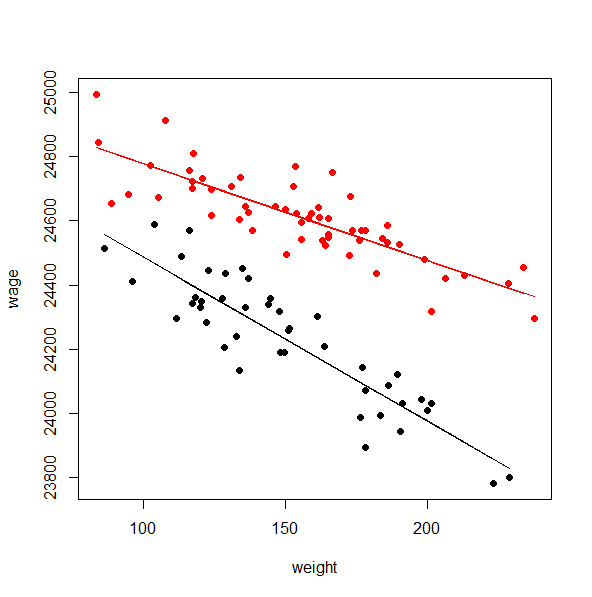Let's say I only wanted to investigate how weight affects wage on
females, but not males. Would it be possible to incorporate this in
one equation? Or would I need a separate regression for each sex?
So, let's just actually show it:
set.seed(81226)
male <- sample(c(1,0), 100, replace=T)
female <- 1 - male
weight <- rnorm(100, 150, 35)
wage <- 25000 - 5 * weight + 1 * male + 2.5 * (male * weight) +
rnorm(100, 0, 100)
m01 <- lm(wage ~ male + weight + male*weight)
summary(m01)
m02<- lm(wage ~ female + weight + female*weight)
summary(m02)
plot(weight, wage, pch=16, col=(male+1))
lines(weight[female==1], m01$fitted[female==1])
lines(weight[male==1], m01$fitted[male==1], col="red")
The first regression using male is:
Coefficients:
Estimate Std. Error t value Pr(>|t|)
(Intercept) 24995.6097 55.7790 448.118 < 2e-16 ***
male 83.2834 73.5968 1.132 0.261
weight -5.0967 0.3627 -14.053 < 2e-16 ***
male:weight 2.0805 0.4723 4.405 2.75e-05 ***
The second regression using female is:
Coefficients:
Estimate Std. Error t value Pr(>|t|)
(Intercept) 25078.8931 48.0124 522.342 < 2e-16 ***
female -83.2834 73.5968 -1.132 0.261
weight -3.0162 0.3026 -9.969 < 2e-16 ***
female:weight -2.0805 0.4723 -4.405 2.75e-05 ***
Graphically, the relationship is:

The red is males, and the black is female. In the first model, female only got the coefficient -5.0967, that is the slope of the black line. The slope of the red line has an adjustment of 2.0805, which is (-5.0967 + 2.0805). The 2.0805 is then the "difference in slopes," aka, the interaction. If both lines are parallel, effect of weight on wage is the same for both sex.
Now, the second mode uses female. The slope for males is -3.0162, which is actually just (-5.0967 + 2.0805) from above. The females' slope has a further adjustment of -2.0805 (notice the sign flip), ending up with -5.0967.
I hope this helps clarifying that your question "effect of weight on female" is the same as "absence of such effect of weight on male." Your proposed question sounds making sense, but to people who understand regression it is closer to a needless gesture.